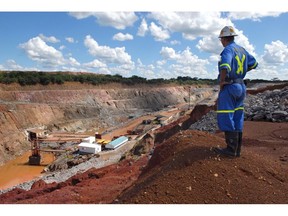Article content
(Bloomberg) — Zambia’s biggest mines are turning to a surprising power source as the copper-producing nation battles an unprecedented energy crisis: South African electricity company Eskom Holdings SOC Ltd., which until March faced its own severe deficit.
An historic drought has stifled hydropower turbines that Zambia relies on for about 85% of supplies. Households have power for just three hours a day. And firms like First Quantum Minerals Ltd. have had to look beyond the nation’s borders for electricity to keep their mines and smelters running.
Article content
Uninterrupted Supply
The shortfall is worse than anticipated just a few weeks ago. Zambia has almost run out of water for generation at Kariba, the world’s biggest man-made reservoir, where it’s weeks away from having to completely shut down for the first time. Maintenance work at the nation’s only coal-fired plant has exacerbated the crunch, raising risks for mine operators in the coming months.
“Power imports from Eskom that were not factored into earlier assumptions are mitigating the impact of this decrease,” Anthony Mukutuma, a director at First Quantum’s Zambian unit, said by email. “As such, we expect power supply to First Quantum Minerals operations to continue uninterrupted.”
Eskom’s transmission unit has a deal to supply 250 megawatts of power to Zambia, and has been doing so since August, the utility said in reply to questions this week. That’s equivalent to more than 10% of Zambia’s normal national demand.
And there are plans to double that within a month under a separate deal with the help of a regional electricity-trading company called Africa GreenCo, Chief Executive Officer Ana Hajduka said in an interview.
Article content
That’s largely thanks to the government’s new rules allowing open access to power-transmission lines, enabling customers like mines to source their own energy through companies like Africa GreenCo. Previously, state-owned Zesco Ltd. dominated the grid.
First Quantum accounts for about half of Zambia’s copper output, and operates Africa’s biggest nickel mine there. The mining industry typically makes up about half of national power demand. While normal generation capacity is about 3,777 megawatts, the plants are currently producing 1,019 megawatts.
Emergency Restrictions
The government has sought to shield the mining industry that generates about 70% of export earnings. Still, Zesco told mines that 40% of their normal supply is subject to emergency restrictions. Operators are sourcing pricier power from the region to make up the shortfall.
Some relief may be on the way. The government forecasts that most of Zambia will receive normal to above normal rains, with thunderstorms starting in October in the western part of the country that feeds Kariba.
Article content
The La Niña weather phenomenon, which the World Meteorological Organization predicts will begin by year-end, brings increased chances of good rains for Zambia’s hydropower dams. But much of the water takes months to reach the reservoirs. Kariba’s waters usually start rising from January or February. It takes years of good rainfall to refill.
A new gas-fired power plant in neighboring Mozambique will by early 2025 add about 450 megawatts to the regional grid.
Yet even with the imports, Zesco still sees a deficit for at least the remainder of 2024. That will hit Zambia’s economic growth, which the government previously estimated will slow to 2.3% this year.
—With assistance from Taonga Mitimingi, Kamlesh Bhuckory, Chris Miller and Paul Burkhardt.
Share this article in your social network

